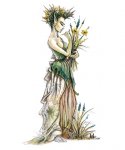In my view, for a D&D nymph or Dryad, and fey in general, you have the following;
Fey creatures are similar to outsiders in that they physically represent some ideal. A Nymph represents the stunning beauty of nature (nature in general); a dryad, on the other hand, represents the purity of an unspoiled forest.
So; a Nymph is beautiful - a physically perfect example of whatever the region's dominant humanoid is. At the same time, she's dangerous and fickle, just like nature.
A dryad is beautiful - as that is an aspect of the unspoiled forest we're covering - but their defining trait is their connection to the forest. They don't /just/ look like maybe burnished wood or have green hair; they look like they were carved from the finest wood of whatever their tree is, and they have leaves and vines for hair. and their outlook would be less fickle and more stolid defender. Not necessarily the "monstrous" dryad of 4e, but definitely nothing anyone would mix up with a nymph (by these definitions).

